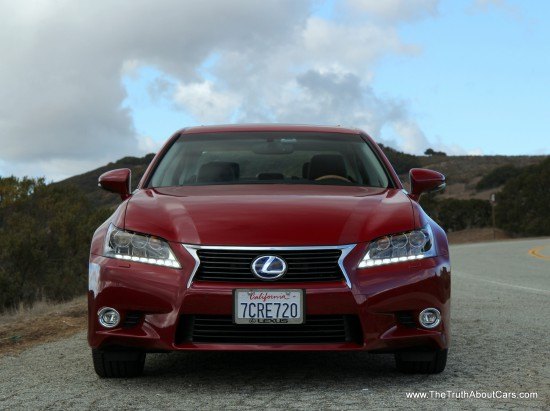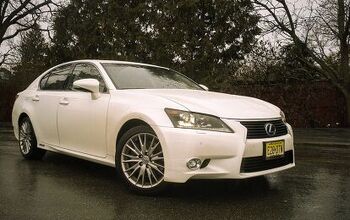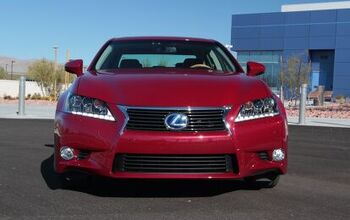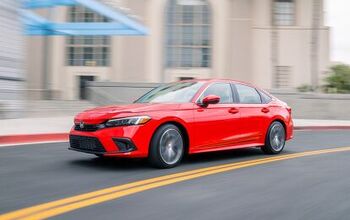Review: 2014 Lexus GS 450h

Last time TTAC looked at the Lexus GS Hybrid, Jack and I descended upon Vegas, drank too much, shared too much and one of us got purse-slapped (it wasn’t Jack). In other news, Jack found the GS a willing partner on the track, I kept drawing comparisons to the Volvo S80 T6 and Hyundai Genesis, and both of us agreed the GS 450h would be the car we’d buy. Despite telling you all that we would have a full review in “a few months,” it has in fact been “a few years.” Since that pair of articles hit, the luxury hybrid landscape has changed dramatically.
The GS used to be the only hybrid game in town, but times have changed and nearly everyone has joined the party. BMW has their turbocharged ActiveHybrid 5, Mercedes just launched the E400 Hybrid, Infiniti has re-badged their M Hybrid the Q70 Hybrid, Acura is finally selling the all-wheel-drive RLX Hybrid and Audi has announced the A6 hybrid will come to America “soon” . This means that the S80 T6 and Genesis are no longer on my list, because we have head-to-head competition now.
Exterior
Lexus used to be known for restrained styling but the current generation GS marked a change for the Japanese luxury brand. In addition to taking on more aggressive front end styling, the GS was the first Lexus to wear the new “spindle” grille. The schnozz that seemed so controversial three years ago seems downright demure today, especially since this form has been adapted to the enormous (and some say questionable) LX 470. Perhaps because the GS was the first to wear the corporate grille, the styling seems slightly awkward from the front 3/4 shot (seen at the top) but looks better in person. Unlike the IS, which gets some sheetmetal swooshes on the side, the GS’s profile and rump are luxury car restrained. Overall I think the Infiniti Q70 hybrid, despite being a little long in the tooth, still wins the beauty contest. The Lexus and BMW are a bit too sedate for my tastes, and the RLX and A6 suffer from decidedly front-wheel-drive proportions when compared to the rest and the Mercedes lands smack in the middle.
Interior
The GS’ interior is dominated by a large and tall dashboard with a strong horizontal theme highlighting a large 12.3-inch LCD. The interior arrangement is certainly dramatic, but causes the cabin to have a slightly oppressive feel in the black shades our tester was cast in. While other car makers are moving to stitched leather dashed, Lexus seems content to blend stitched pleather and injection molded parts together. The combination of textures and “un-lacquered” bamboo (exclusive to the hybrid) make the interior look Scandinavian. The light wood is more attractive in person than pictures might indicate, and while I question the “renewable resource” marketing on a large luxury sedan, like the hybrid drivetrain, I’m sure it will make shoppers feel special.
Base hybrid models get very comfortable 10-way power front seats, but most of the GS 450h sedans I saw on the lot were equipped with 18-way seats. The high-end throne sports the same types of articulation as BMW’s excellent “sport seats” with an articulating back, inflating bolsters, adjustable thigh support, four-way lumbar and “butterfly” headrests. Needless to say, if you have trouble finding a comfortable seating position, you’re not human. This puts the GS hybrid at a distinct advantage in front comfort over the Mercedes, Audi and Infiniti models. Out back the GS’s rear seats are spacious, comfortable and optionally heated. While the Lexus and Infiniti fail to offer a folding rear seat, the Mercedes E400 hybrid has a generous cargo pass-through behind its optional 60/40 rear thrones.
Infotainment
Wide-screen infotainment systems are all the rage, so Lexus dropped a 12.3-inch LCD in the dash. The system ditches the intuitive touchscreen interface Lexus used for the better part of a decade for the Lexus joystick (it’s officially called Lexus Remote Touch) but importantly doesn’t alter the software to adapt to the input method. I hate it. It occupies a great deal of room on the center console, and it takes far more hand-eye-brain coördination than a touchscreen. Every time I am in a Lexus I find myself glancing at the screen and fiddling with the little control pad far more than when I’m in a competitor’s luxury sedan. This increased distraction hasn’t gone unnoticed by my better half who constantly nags me about keeping my eyes on the road. Want to enter an address using the on-screen QWERTY keyboard? It’s obvious why Lexus won’t let you do that in motion.
To soften the blow Lexus throws in the same media device voice command interface as the other Lexus and premium Toyota products receive. The system is snappy, managed to figure out every command I threw at and has a more natural sounding voice than MyLincoln Touch. Helping counter the nagging LRT caused (see how that’s not my fault now), the available Mark Levinson sound system can drown out even the most shrill mother-in-laws.
Perhaps reinforcing that Lexus focuses on the “meat” of the luxury segment and not the one-percent, you won’t find the same level of gee-wizardry in the GS as some of the Euro competitors, even in this top-end hybrid model. You won’t find night vision, a full-leather dashboard, expensive ceramic knobs, massaging front seats, or LCD instrument clusters. Instead, Lexus doubles down on perfect seams, quiet cabins, a high level of standard equipment and quantities of bamboo that would Lumber Liquidators make blush.
Drivetrain
While the GS 350 recently got an update in the form of a new Aisin 8-speed automatic, the GS 450h continues with just a minor software update. This means under the hood you will find the same direct-injection 3.5L Atkinson-cycle V6 engine and RWD hybrid transmission that launched in 2011. Combined with a 1.9 kWh NiMH battery pack in the trunk the system is good for 338 combined horsepower, 286 of which come from the gasoline engine. This is essentially the same engine found in the Highlander and RX hybrids, but the transmission is more similar to what Lexus uses in the LS 600hL. The unit combines the two motor/generator units with a 2-speed planetary gearset to improve efficiency at high speeds (as in on the Autobahn) but without the AWD system standard in the LS 600hL. The 2014 software update improves “sportiness” in sport mode and now imitates an 8-speed automatic instead of a 6-speed. While 338 horsepower compares well with the 6-cylinder competition, the GS 450h has the unenviable task of trying to be both the most efficient GS and the performance version as well. For reasons nobody knows, the more efficient GS 300h which uses a 2.5L four-cylinder engine is not sold in America.
By design, the Lexus hybrid system is very different from the competition. The two motor/generator units and the electrical circuitry combine with a single planetary gearsest to “act” as a continuously variable transmission. This setup allows the drivetrain to act as a serial hybrid (kind of), parallel hybrid, electric generator, or a pure EV at low speeds. In contrast Mercedes, BMW and Infiniti combine a traditional transmission with a single electric motor that replaces the torque converter. Transitions between electric and gasoline drive modes in these systems aren’t as smooth as the Lexus system because of the clutch packs involved in reconnecting the engine. Meanwhile Acura combines a dual-clutch robotic manual transmission with a twin-motor pack in the rear for the only AWD hybrid luxury sedan in this category.
Pricing
GS 450h pricing starts at $60,430 which is a considerable jump from the $47,700 GS 350, but in true luxury car fashion, you may be disappointed with what $60,000 buys you. Unlike BMW and Mercedes which offer plenty of ala carte options, the GS hybrid comes in three feature levels. Base models don’t get navigation or snazzy LED headlamps. If you want those toys plus the 18-way front seats, semi-aniline leather, steering headlamps, heated steering wheel, 3-zone climate control, black and white heads up display, blind spot monitoring and a trunk mat, be prepared to lay down $72,062. A fully loaded $76,726 example gets the buyer heated rear seats, headlamp washers, a “high intensity heater” (an electric heater that will heat the cabin faster in cold weather), a windshield de-icer, water-repellent glass, radar cruise control with pre-collision warning, lane keeping assistant, remote engine starter, glass breakage sensor and a rear spoiler.
76 large may sound like an expensive buy, but the ActiveHybrid 5 takes the cake with a starting price of $61,400 and a fully loaded price of $87,185. Acura has been cagey about RLX hybrid pricing but their presentation at the launch indicated they plan on following Lexus’s pricing structure quite closely. Meanwhile, the Mercedes E400 hybrid delivered an unexpected value proposition with a low $56,700 starting price and when fully equipped with features not available on the GS it manages to still be slightly cheaper at $76,095. The Infiniti hybrid hasn’t changed its value proposition despite the name change and the Q70’s $55,550-$67,605 is the lowest in the group. Audi hasn’t announced A6 hybrid pricing but I expect it to slot in around the E400.
Drive
To put things in the right perspective, I have to go back to the GS hybrid’s conflicted mission. Since Lexus decided to kill off the V8 GS sedan in this generation, Lexus doesn’t have a direct answer to the BMW 550i, Mercedes E550, Audi S6, or even the Infiniti Q70 5.6 (formerly known as the M56). This means the GS 450h has a secondary mission as the top-end GS trim while the other hybrids (except for the RLX) are middle-tier options and this puts the GS in an odd bind. Lexus tells us that the reason the GS lacks a V8 is that only 5% of the Germans are shipped with one. While that may be true in Europe, it certainly doesn’t seem to be the case in California.
The split mission is most obvious when it comes to the performance numbers. Despite having more power than the GS 350, the GS 450h is slower to 60 than its gasoline-only stable mate and considerably slower than the BMW, Infiniti, and even the Acura with the only the Mercedes being slower to highway speed. Still, 0-60 in 6-seconds is hardly slow and the GS performs the task with the silence and serenity you expect from a luxury sedan. Although Lexus describes the transmission as an eCVT, this isn’t a belt/pulley CVT like you find in economy cars. As a result, it feels more civilized and less “rubber-bandy.” I found the CVT manners throughly appropriate for a luxury car and the smooth acceleration befits a brand built on smooth drivetrains. Unlike a “real CVT,” engaging the eight imitation speeds is quick and easy with fast shifts from one “gear” to another. Unfortunately this does little for the GS hybrid’s sport credentials and in no way helps it compete with the V8s from the German competition.
Although the GS gives up plenty in the thrust-department, it really shines in the bends. The GS’s chassis is well sorted and nearly perfectly balanced. All GS hybrid models get a standard adaptive suspension system with several levels of damping, but unlike the air suspension in the Lexus LS, the GS’s adaptive suspension is based on electronically controlled struts much like the BMW system. This eliminates the “disconnected” and “floaty” feeling you get with air suspensions found on full-size luxo-barges. When pushed in the corners the GS quite simply feels better than the BMW. Yep. I said it. Today’s 5-series has a more luxurious mission in mind, so the little it gives up to the GS shouldn’t surprise anyone. The Mercedes and Infiniti feel very accurate, although heavy, and the Audi and RLX are a mixed bag. Unless Audi works some unexpected magic, the A6 hybrid will remain decidedly nose-heavy. The Acura RLX, although it has a similar weight distribution problem as the Audi, has a slick torque vectoring AWD system in the back. Not only can the RLX torque vector in power-on situations like a electronically controlled conventional rear axle, but it can torque vector in “neutral” and “power off” situations as well. Although the RLX feels by far the most “artificial” in the group on winding mountain roads, it is one of the better handling sedans and at the moment the only AWD hybrid in this category.
Of course the primary reason for buying a hybrid is to save on gas. Right? Maybe. With a 29 MPG City, 34 MPG Highway and 31 MPG combined rating there’s no doubt that the GS 450h is a fuel sipping 338 horsepower luxury sedan. However at more than $10,000 more expensive than a similarly equipped GS 350 it would take you more than 20 years to “save money.” We did average an excellent 31.5 MPG over 800 miles with the GS hybrid, a notable improvement over the Infiniti hybrid and the short time I spent in the RLX hybrid. Although we haven’t extensively tested the BMW and Mercedes hybrids yet, brief spins in both indicate they will slot in under the GS. There’s one more problem for the GS: Mercedes’ new E250 diesel. No, it’s not a speed daemon, but at 34 mpg combined it not only makes up for the higher cost of diesel with the higher fuel economy, it starts around $9,000 less than a GS 450h as well.
The GS 450h is without a doubt the best Lexus GS sedan available. It gives up little in terms of performance while delivering excellent fuel economy, a quiet and comfortable cabin and most of the gadgets and gizmos a luxury shopper could buy. Trouble is, unless the Lexus dealer is the only game in town, nearly every other alternative in this segment has a list of reasons to buy it over the GS. The RLX has a trendy AWD system despite the discount brand association, the Q70’s brand image isn’t quite as premium but it’s thousands less, the Mercedes takes the sweet spot in the middle known as “value” (how’s that for a surprise?) and the BMW offers the best performance and the biggest list of options if you can afford it. As the top end trim for the GS line the 450h also has troubles coming in just about as expensive as the competition’s V8 offerings but offering no better performance than the GS 350. The biggest problem for the GS however is the price. If the GS 450h was $5,000-$7,000 less expensive, this would be an easy win. As it is, the GS manages to be the car I liked the most in this segment, but the one I’d be least likely to buy.
Lexus provided the vehicle, insurance and one tank of gas for this review
Specifications as tested
0-30: 2.88 Seconds
0-60: 6.01 Seconds
1/4 Mile: 14.49 Seconds @ 104 MPH
Average observed fuel economy: 31.5 MPH over 800 miles
Cabin noise at 50 MPH: 68 dB

More by Alex L. Dykes
Latest Car Reviews
Read moreLatest Product Reviews
Read moreRecent Comments
- Jeff JMII--If I did not get my Maverick my next choice was a Santa Cruz. They are different but then they are both compact pickups the only real compact pickups on the market. I am glad to hear that the Santa Cruz will have knobs and buttons on it for 2025 it would be good if they offered a hybrid as well. When I looked at both trucks it was less about brand loyalty and more about price, size, and features. I have owned 2 gm made trucks in the past and liked both but gm does not make a true compact truck and neither does Ram, Toyota, or Nissan. The Maverick was the only Ford product that I wanted. If I wanted a larger truck I would have kept either my 99 S-10 extended cab with a 2.2 I-4 5 speed or my 08 Isuzu I-370 4 x 4 with the 3.7 I-5, tow package, heated leather seats, and other niceties and it road like a luxury vehicle. I believe the demand is there for other manufacturers to make compact pickups. The proposed hybrid Toyota Stout would be a great truck. Subaru has experience making small trucks and they could make a very competitive compact truck and Subaru has a great all wheel drive system. Chevy has a great compact pickup offered in South America called the Montana which gm could be made in North America and offered in the US and Canada. Ram has a great little compact truck offered in South America as well.
- Groza George I don’t care about GM’s anything. They have not had anything of interest or of reasonable quality in a generation and now solely stay on business to provide UAW retirement while they slowly move production to Mexico.
- Arthur Dailey We have a lease coming due in October and no intention of buying the vehicle when the lease is up.Trying to decide on a replacement vehicle our preferences are the Maverick, Subaru Forester and Mazda CX-5 or CX-30.Unfortunately both the Maverick and Subaru are thin on the ground. Would prefer a Maverick with the hybrid, but the wife has 2 'must haves' those being heated seats and blind spot monitoring. That requires a factory order on the Maverick bringing Canadian price in the mid $40k range, and a delivery time of TBD. For the Subaru it looks like we would have to go up 2 trim levels to get those and that also puts it into the mid $40k range.Therefore are contemplating take another 2 or 3 year lease. Hoping that vehicle supply and prices stabilize and purchasing a hybrid or electric when that lease expires. By then we will both be retired, so that vehicle could be a 'forever car'. And an increased 'carbon tax' just kicked in this week in most of Canada. Prices are currently $1.72 per litre. Which according to my rough calculations is approximately $5.00 per gallon in US currency.Any recommendations would be welcomed.
- Eric Wait! They're moving? Mexico??!!
- GrumpyOldMan All modern road vehicles have tachometers in RPM X 1000. I've often wondered if that is a nanny-state regulation to prevent drivers from confusing it with the speedometer. If so, the Ford retro gauges would appear to be illegal.
































































Comments
Join the conversation
Very elaborate description has been done here, any car enthusiasist will definitely get benefited from this blog. This 2014 Lexus GS 450h has holding a good rank in Luxury Large Cars.
Great review! I've been a fan of the GS since I first saw it in Japan. It was a twin turbo named Toyota Aristo. The new GS is gorgeous inside and out. There's something about the design that draws you in. Some say it's a very bland and boring design. I must disagree.